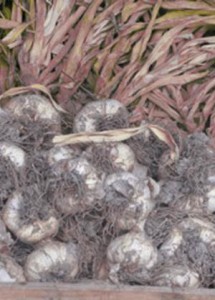
More evidence that low-calorie sweeteners are bad for your health
Studies show that artificial sweeteners can raise the risk of hypertension, metabolic syndrome, type 2 diabetes and heart disease, including stroke.

Autumn has definitely arrived. The nights are drawing in and the mornings take a while to warm up (if we are lucky enough to have a sunny day).
The crops are slowing down as day lengths get shorter and shorter and any sun that appears gives a far less powerful heat. We have just started planting some of our over-wintering salad in the tunnels, which replace all of the summer crops as they fade. We are also starting to plant garlic and looking for a dry spell to cultivate for planting spring cabbage and over-wintering spring onions.
We have settled on growing two varieties of garlic and have saved the best cloves from this year’s harvest to replant. The varieties are Early Wight, which we use to provide early wet garlic from mid-May and then Albigensian which produce a large white bulb a little later and stores better than the Early Wight.
We also grow Elephant garlic which are treated much the same, but planted at slightly wider spacings. Garlic cloves are planted at about 3cm deep and about 25cm apart and then mulched with compost and straw which saves time hoeing and weeding as well as providing nutrients and helping to retain moisture and improve soil drainage and structure.
Broad beans will be sown either at the end of the month or beginning of November to get a head start over the spring sown crop. We usually sow Aquadulce as an over-winter variety.
Preparing the ground for winter
October is the last chance to sow green manures, and although it is too late to sow most nitrogen fixing plants such as clover, cereal rye is an excellent soil cover over winter. It is very good at holding onto nutrients that may otherwise be washed through the soil and leached away by the rains of winter. We are sowing a cereal rye and vetch mix over many areas that have finished cropping and would otherwise be left bare.
Any other areas that we finish cropping from later this month, which will be too late to sow any green manures, will be covered with a mulch of straw from the farm. The worms seem to really enjoy the straw mulch and it is slowly taken in over the winter, with any residual straw being raked off and added to the compost in the spring.
Looking back, and forward
Hearting chicories start to heart up well in October, and the salad mix changes with the addition of these. The oriental leaves and other interesting leaves such as American land cress and claytonia are also coming into abundance, with less lettuce, which suffers from mildew at this time of the year.
October is when we start reflecting on the year and think about changes that we will make next year. It is easy to look at what crops have not performed well this year and think about growing less of them next year. However, it has been an extreme year of weather, and hopefully next year will be different.
So it is important not to just grow the crops that did well this year, as the weather may well be quite different next year. More important is to continue growing a wide variety of crops using resilient and disease resistant varieties so there is no reliance on one main crop and the risk of failure is minimised.
In the kitchen
The hedgerows at Trill are ablaze with colour. They have provided us with an abundance of rosehips and blackberries. We have been busy harvesting and turning them into chutneys and jams and infusing Trill cider vinegar for salad dressings and vodka for warming winter cocktails.
Rosehip Chutney
Here is one of our all time favourite chutneys.
Ingredients
Method
1 Soak the rosehips, sultanas, and apples in the vinegar overnight.
2 After soaking, place the rosehips with remaining ingredients in a large, heavy saucepan. Bring the mixture to a boil over high heat, then reduce heat and simmer, stirring occasionally, until mixture is thickened.
3 Leave to cool, then place chutney in clean, dry jars, secure with a lid and store in a cool place.
Keep for at least a month before using.
Wilted kale with garlic and thyme
Trill garden has a variety of different kale growing at the moment. Kale is my all time favourite and wilted kale with garlic and thyme is easy, quick and nutritious.
Ingredients
Method
1 Cook the onion in the oil for 2 minutes, add the garlic and kale and cook for a further 2 – 3 minutes until the kale has wilted and turned a glossy dark green.
2 Toss in the thyme and the stock and cook for a further 2 minutes or until the stock has evaporated. Serves 4.

Please subscribe me to your newsletter mailing list. I have read the
privacy statement